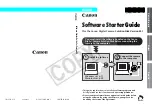
DEC Text Processing Utility Data Types
3.7 Pattern Data Type
for the pattern, the built-in returns a range that contains the text that matches
the pattern. You can assign the range to a variable.
The following example uses strings and pattern operators to create a pattern that
is stored in the variable my_pat. The variable is then used with the SEARCH
or SEARCH_QUIETLY built-in procedure in a forward direction. If SEARCH
or SEARCH_QUIETLY finds a match for my_pat, the range of matching text is
stored in the variable match_range. The POSITION built-in procedure causes the
editing point to move to the beginning of match_range.
my_pat := ("abc" | "def") + "::";
match_range := SEARCH (my_pat, FORWARD);
POSITION (match_range);
3.7.1 Using Pattern Built-In Procedures and Keywords
The following built-in procedures return values of the pattern data type:
•
ANY
•
ARB
•
MATCH
•
NOTANY
•
SCAN
•
SCANL
•
SPAN
•
SPANL
See the DEC Text Processing Utility Reference Manual for a complete description
of these pattern built-in procedures.
3.7.2 Using Keywords to Build Patterns
You can use the following keywords as the first argument to the SEARCH or
SEARCH_QUIETLY built-in procedures. You can also use them to form patterns
in expressions that use the pattern operators. See the DEC Text Processing
Utility Reference Manual for a complete description of these keywords.
•
ANCHOR
•
BUFFER_BEGIN
•
BUFFER_END
•
LINE_BEGIN
•
LINE_END
•
PAGE_BREAK
•
REMAIN
•
UNANCHOR
3–12 DEC Text Processing Utility Data Types
















































